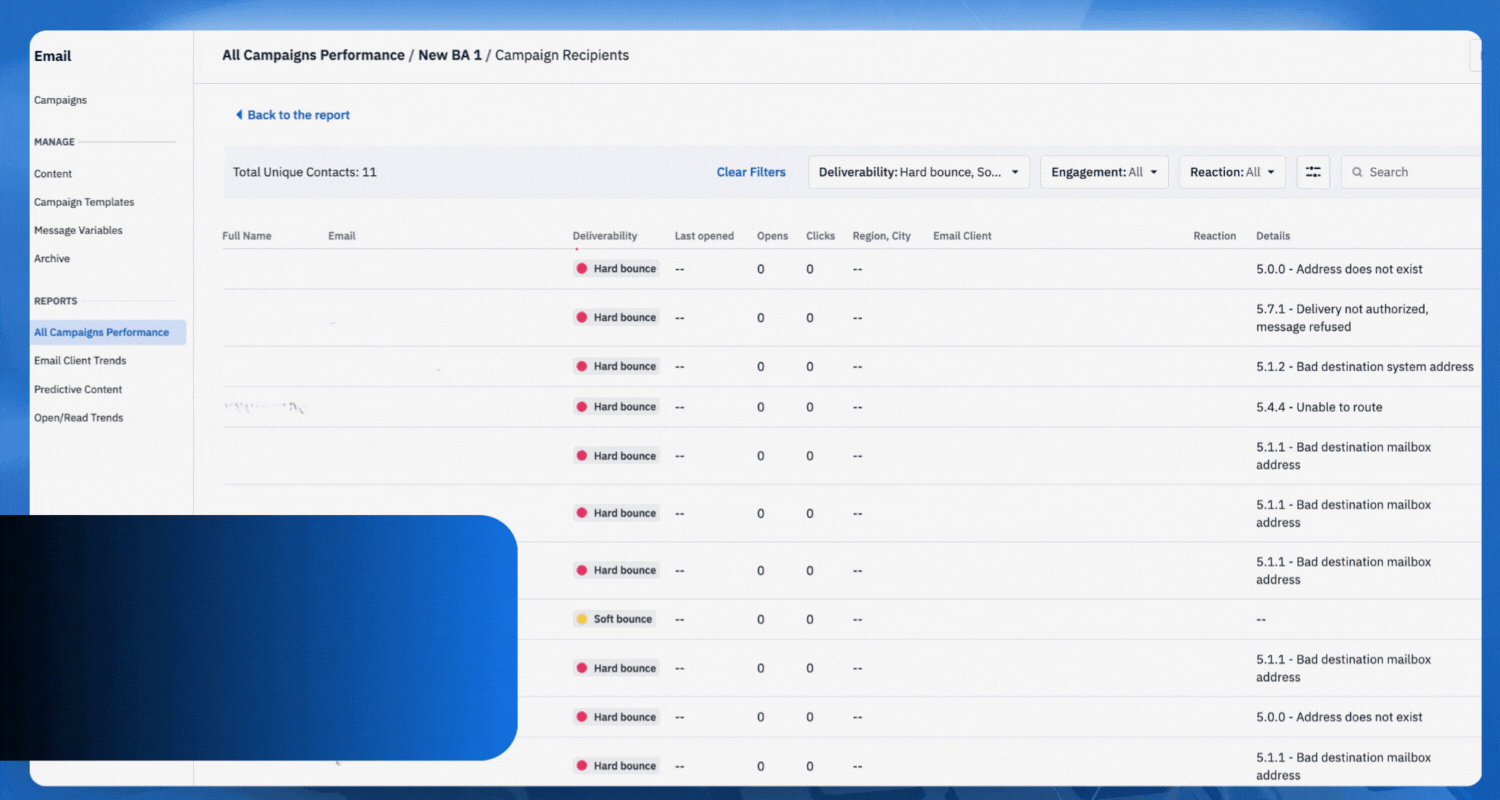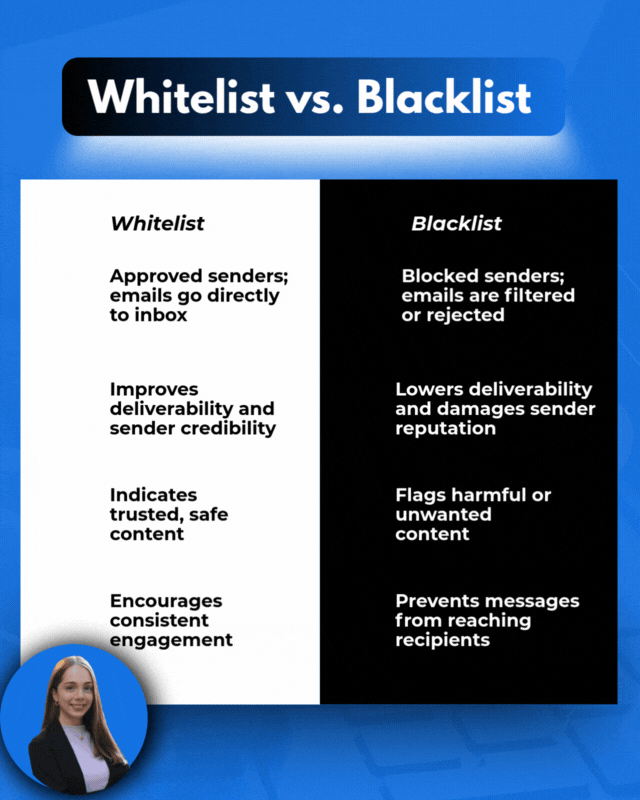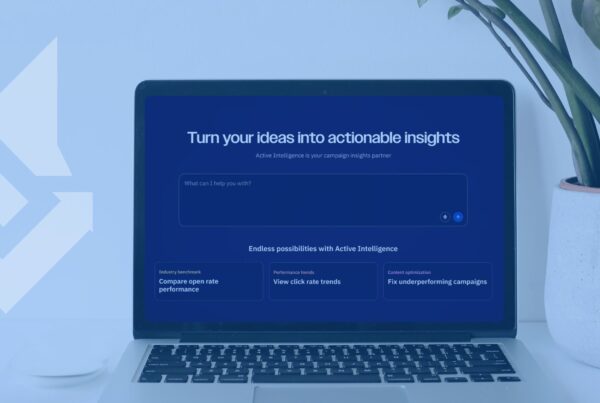Last updated on December 1st, 2025 at 08:18 am
You’ve just spent hours creating the perfect email campaign. The copy is engaging, the subject line is irresistible, and the list is carefully targeted. You hit send, eager to watch the results roll in, but instead, your inbox starts filling with dreaded “Message Undelivered” notifications.
It’s more than frustrating. Every bounce represents a missed opportunity and wasted resources. This is the core of the hard bounce vs soft bounce dilemma, where high bounce rates don’t just stop a single campaign from performing well; they can cripple your deliverability and hurt your sender reputation with email service providers.
That’s why understanding the difference between a hard bounce and vs soft bounce and knowing how to manage them is critical for maintaining a healthy, high-performing email list.
Contents
What Is a Hard Bounce vs a Soft Bounce?
In email marketing, not every message you send will reach its destination. Sometimes, it’s a temporary roadblock; other times, it’s a permanent dead end. That’s where understanding hard bounce vs soft bounce becomes essential.

Soft Bounce (Temporary Issue)
When evaluating a hard bounce vs soft bounce, the soft bounce is the less severe of the two. It occurs when your email fails to reach the recipient, but the problem isn’t permanent. Think of it like a delivery truck arriving at a house but being unable to hand over the package because the gate is temporarily locked.
Common reasons for a soft bounce include:
- Full inbox: The recipient’s mailbox is out of storage space, so it can’t accept new messages until it’s cleared.
- Mail server downtime: The recipient’s email server is temporarily offline, overloaded, or under maintenance when your email arrives.
- Message size exceeding limits: Your email is too large, often because of high-resolution images or bulky attachments.
Most email platforms will automatically retry sending soft-bounced emails for a certain period, often up to 72 hours. If the temporary problem is resolved, the message will go through. If not, repeated soft bounces may turn into hard bounces over time.
Hard Bounce (Permanent Issue)
On the other side of the hard bounce vs soft bounce debate is the permanent delivery failure. No matter how many times you try, the email will never reach its destination. Imagine that delivery truck pulling up to an empty lot where a house used to be, there’s simply nowhere for the package to go.
Typical causes of hard bounces include:
- Nonexistent email address: The contact may have changed their email, or there was a typo when it was collected
john.doe@gamil.cominstead ofgmail.com
- Invalid or expired domain: The domain is no longer active or was entered incorrectly.
- Server permanently blocking your messages: The recipient’s server has decided your emails are unwanted and is rejecting them outright.
Hard bounces are like flashing warning signs for your sender reputation. They tell Internet Service Providers that your list may be outdated or poorly maintained, which can lead to your future messages being flagged as spam. The best practice is to remove these addresses immediately to keep your list clean and your campaigns healthy.
7 Common Hard Bounce vs Soft Bounce Mistakes to Avoid
ZeroBounce (July 2025) warns that a bounce rate above 2% can lower deliverability and threaten revenue.
Understanding the nuances of hard bounce vs soft bounce is key to avoiding these common pitfalls.
1. Ignoring Bounce Rate Thresholds
ISPs like Gmail and Outlook closely monitor bounce rates. If your rate exceeds 2%, they may classify you as a spam risk.
Example: A small business with a 5% hard bounce rate saw open rates drop from 35% to 8% because their emails were filtered to spam.
2. Resending to Hard Bounce Addresses
Once an email address hard bounces, resending to it damages your reputation and risks blacklisting.
Example: An e-commerce brand kept sending to invalid emails and was blacklisted within weeks.
3. Treating Repeated Soft Bounces as Harmless
Repeated soft bounces often mean the address is no longer valid.
Example: A B2B company ignored soft bounces from outdated corporate domains, which later became hard bounces.
4. Neglecting Double Opt-In Verification
Without double opt-in, your list may fill with fake or mistyped addresses.
Example: A contest signup without verification led to a 7% hard bounce rate due to invalid entries.

5. Overlooking Email Authentication
Without SPF, DKIM, and DMARC records, recipient servers may reject your messages, causing soft bounces.
Example: A SaaS company forgot to set up authentication after a domain change, resulting in increased bounce rates.
6. Using Purchased Email Lists
Purchased lists often include spam traps, outdated emails, and invalid domains.
Example: A real estate agent bought a “verified” list, half of which bounced, leading to account suspension.
7. Skipping Regular List Cleaning
Email lists naturally decay as people change jobs or accounts.
Example: A nonprofit using a 5-year-old list saw bounce rates jump from 1.5% to 6% in one campaign.
Why Bounced Emails Hurt Your Campaigns
Ignoring bounces can be costly. Understanding hard bounce vs soft bounce is more than a technical exercise; it’s a critical step in protecting your brand, improving deliverability, and maximizing ROI.
Damaged Sender Reputation
Every email you send is being watched by Internet Service Providers (ISPs) like Gmail, Outlook, and Yahoo. When they detect a high number of bounces, especially hard bounces, they see it as a sign your list isn’t well-maintained. This poor list hygiene makes ISPs more likely to filter your future messages straight into spam folders, even for valid recipients who want to hear from you.
Example: A retailer with a growing subscriber base neglected to remove invalid emails. Within two months, their inbox placement dropped dramatically, cutting campaign effectiveness in half.
Wasted Resources
Designing and sending a campaign takes time and money. Every undelivered email in the hard bounce vs soft bounce conflict represents wasted effort and budget.
Lost Leads and Sales Opportunities
Each bounce is more than just a failed delivery; it’s a lost connection. A hard bounce might mean a potential customer changed jobs, and you never updated their details. A soft bounce could be the difference between a time-sensitive offer landing in someone’s inbox and missing the deadline entirely. In either case, the result is the same: a missed opportunity for engagement, conversion, or sale.
Lower Campaign Performance
Bounces don’t just affect deliverability; they skew your performance metrics. High bounce rates lower your open rates, click-through rates, and overall engagement numbers. This creates a false impression that your campaigns are underperforming, which can lead to misinformed marketing decisions.
For example, if you’re A/B testing subject lines, inflated bounce rates can make the data unreliable, meaning you might choose the wrong “winner” and miss out on better results.
Risk of Blacklisting
Perhaps the most damaging consequence of high bounce rates is the risk of blacklisting. If ISPs or anti-spam organizations determine you’re consistently sending to invalid addresses, a common result of high hard bounce rates, they may blacklist your domain or IP. Once that happens, your emails will be blocked entirely, and recovering from it can take weeks or even months.
Blacklist removal often requires technical intervention, proof of list cleanup, and in some cases, changing your sending infrastructure altogether.
Whether you’re dealing with a temporary soft bounce or a permanent hard bounce, both sides of the hard bounce vs soft bounce equation can have ripple effects. The sooner you act, the better.

How to Proactively Manage Bounces
Bounces will happen in any email marketing campaign, but how you handle them determines whether they remain a small hiccup or spiral into a deliverability disaster. Managing hard bounce vs soft bounce effectively means addressing issues quickly, preventing future problems, and keeping your list healthy.
For Soft Bounces (Temporary Issues)
Soft bounces are like temporary roadblocks, frustrating but often fixable.
- Wait and monitor: Most email service providers will automatically retry delivery for up to 72 hours. This allows time for issues like server downtime or a full inbox to be resolved.
- Track repeated offenders: If the same address soft bounces three or more campaigns in a row, treat it as a hard bounce. Repeated temporary issues usually mean the address is no longer valid.
- Check message size: Oversized emails with large images or attachments can trigger soft bounces. Compress images and keep file sizes reasonable.
Example: A webinar invite failed to deliver to 5% of recipients due to oversized attachments. After compressing files and sending again, the delivery rate jumped to 99%.
For Hard Bounces (Permanent Issues)
In the hard bounce vs soft bounce comparison, this is the one that requires immediate, decisive action.
- Remove the address immediately: Continuing to send to invalid addresses damages your sender reputation and risks blacklisting.
- Double-check for typos: Some hard bounces are avoidable. A simple spelling error like
john.smith@gamil.cominstead ofgmail.comcan be corrected. - Investigate domain issues: If the domain has expired or is inactive, there’s no recovery path. Remove it to keep your list clean.
Example: A retailer noticed multiple bounces from the same corporate domain. Upon checking, they learned the company had been acquired and their email system shut down — a clear sign to remove those addresses permanently.
To Prevent Future Bounces
Proactive list management is the most effective way to keep bounce rates low.
- Require double opt-in: This ensures new subscribers confirm their email address before joining your list, reducing typos and fake sign-ups.
- Authenticate your domain: Set up SPF, DKIM, and DMARC to prove your emails are legitimate, improving deliverability and reducing policy-based rejections.
- Clean your list regularly: Quarterly list scrubs help remove inactive users and outdated addresses before they cause problems.
- Avoid purchased lists: Bought contacts often contain spam traps, invalid addresses, and low-quality leads that can ruin your sender score.
- Implement a sunset policy: Automatically remove subscribers who haven’t engaged after a set period, typically 6–12 months.
Treat managing hard bounce vs. soft bounce as an ongoing process to maintain higher deliverability and make every email count.
Frequently Asked Questions
Can a soft bounce turn into a hard bounce?
Yes, this is a key point in the hard bounce vs soft bounce relationship. If a temporary issue (like a full inbox) is never resolved and the account is abandoned, it can eventually become a hard bounce.
Do bounces affect open rates?
Absolutely. Both sides of the hard bounce vs soft bounce issue affect your reputation. High rates lead to poorer inbox placement, which lowers the number of people who even see your email, thus reducing open rates.
What is a healthy bounce rate?
Under 2% is considered safe.
Should I manually contact bounced addresses?
For soft bounces, yes, if the lead is valuable. For hard bounces, it’s not worth it unless you have a new, valid address.
Conclusion
Mastering the management of hard bounce vs soft bounce is not just a best practice. It is the foundation of successful email marketing. Every bounce you ignore chips away at your sender reputation, erodes deliverability, and leaves potential leads and sales on the table.
By avoiding the seven common mistakes we have covered, you take control of your campaigns instead of leaving them at the mercy of undelivered messages. You protect your reputation with ISPs, ensure your audience sees your content, and get a more accurate picture of your campaign performance.
When it comes to hard bounce vs soft bounce, the goal is clear: keep your list healthy, your reputation strong, and your messages exactly where they belong, which is right in the inbox, ready to be opened. Schedule a call with us today, and let’s get your email marketing performing at its best.






